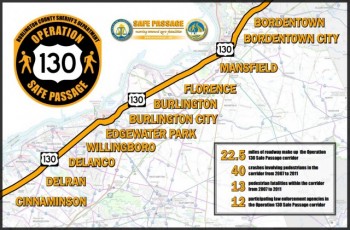
Year after year, pedestrians have been killed while walking along or attempting to cross Route 130 in Burlington County — the most dangerous road for walking in all of New Jersey. According to the most recent federal data, 12 pedestrians were killed on Route 130 between 2010 and 2012.
Last year, the Burlington County Sheriff’s Department received $225,000 from the state for “Operation 130 Safe Passage,” a program to step up enforcement of reckless driving on the roadway. It’s been a year since the program’s inception, and so far there have been zero fatalities. While this is an enormously positive step forward, it’s also essential to physically transform Route 130 to ensure the safety and comfort of pedestrians after the increased enforcement operation ends.
Pedestrians use Route 130 to reach work, shops and bus stops that dot the highway. Like nearly all of the most dangerous roads for pedestrians in the region, Route 130 is a multi-lane arterial road with fast-moving traffic and few sidewalks, and even fewer crosswalks. Pedestrians often have to walk more than a half-mile out of their way just to reach a crosswalk. In many instances, walking on Route 130 involves navigating a muddy patch of grass rather than a safe sidewalk, and darting across the road, hoping to make it all the way across before the light changes, rather than having access to a median or refuge island to rest in if you’re a slower walker.
Thankfully, the Burlington County Sheriff’s Office and the City of Burlington recognize the need for long-term solutions and have engaged the New Jersey Department of Transportation to study redesigning Route 130 for safer travel on foot. It remains to been seen what solutions will be proposed, but in order to truly transform Route 130, Tri-State urges NJDOT to address the following:
- Installing continuous, connected sidewalks throughout the entire corridor;
- Adding protected bicycle lanes, which increase safety for bicyclists while helping to calm motor vehicle traffic;
- Creating pedestrian islands to give people crossing the roadway a safe place to stop if they can’t cross the street in one WALK cycle;
- Lowering speed limits to increase safety for all road users;
- Exploring a traffic calming “road diet,” which would decrease the number of lanes;
- Longer term planning to coordinate roadway design and land uses along the corridor to transform Route 130 from a highway to a boulevard that not only facilitates multiple modes, but also bolsters economic development.
It seems likely that the crackdown on motor vehicle violations coupled with the media focus on the high number of pedestrian fatalities on the roadway has, at least temporarily, made it safer. Local police and public safety officers should be applauded for their efforts. However, when the increased enforcement inevitably ends, Route 130 will remain an unsafe and unpleasant place to walk until physical improvements are made.

[…] which named Route 130 the most dangerous road in New Jersey for the fifth year in a row. Now more than ever, it is clear that Route 130 must be transformed to allow all road users to travel […]
[…] which named Route 130 the most dangerous road in New Jersey for the fifth year in a row. Now more than ever, it is clear that Route 130 must be transformed to allow all road users to travel […]
[…] more lives this past March — should be a top priority for NJDOT. Tri-State has pushed for improvements to the notorious arterial including the addition of continuous sidewalks, mid-block crossings and […]